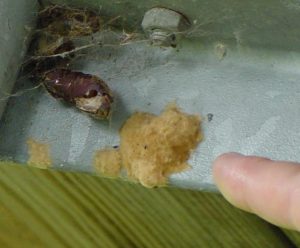
Gypsy moth egg mass
Early fall is the best time for property owners to determine whether gypsy moths will be a problem next year. Gypsy moth egg masses are tan-colored and about the size of a nickel or quarter. Egg masses will not hatch until next spring, which means landowners have plenty of time to plan to minimize gypsy moth damage next summer. New egg masses produced this year feel hard, whereas those that are older are soft and appear faded. Most egg masses will be found on tree trunks and the undersides of branches, but they can also be found on buildings, firewood piles, vehicles and other outdoor objects.
If there are only a few egg masses on a property, they can be treated with egg mass oil or simply scraped into a can and soaked overnight in soapy water. If there are many egg masses, remove those within reach and consider insecticides or physical controls such as sticky barriers and burlap bands next spring and summer when caterpillars are present.
Infestations of many egg masses per tree over a larger area such as a neighborhood or woodlot are best treated from the air. In this case, landowners should discuss gypsy moth control with their neighbors then contact their local government to request that their area be sprayed through the DNR Gypsy Moth Suppression Program. The DNR offers aerial spraying to communities and landowners through participating county governments. The deadline for counties to apply for the program is December 1, 2017. Inexpensive aerial spraying is available for infestations of 20 acres or more that are severe enough to cause tree defoliation and mortality. Participating landowners and communities may be able to receive reimbursement for up to 50% of the cost of spraying done through the DNR program.
Landowners and groups such as lake associations may be able to hire an aerial applicator directly. Woodlot owners should talk with a forester to determine whether aerial spraying would be appropriate for their property.
More information about population sampling and management options is available online at www.gypsymoth.wi.gov.
Written by Bill McNee, DNR Forest Health Specialist, Oshkosh
bill.mcnee@wisconsin.gov or (920-360-0942)
